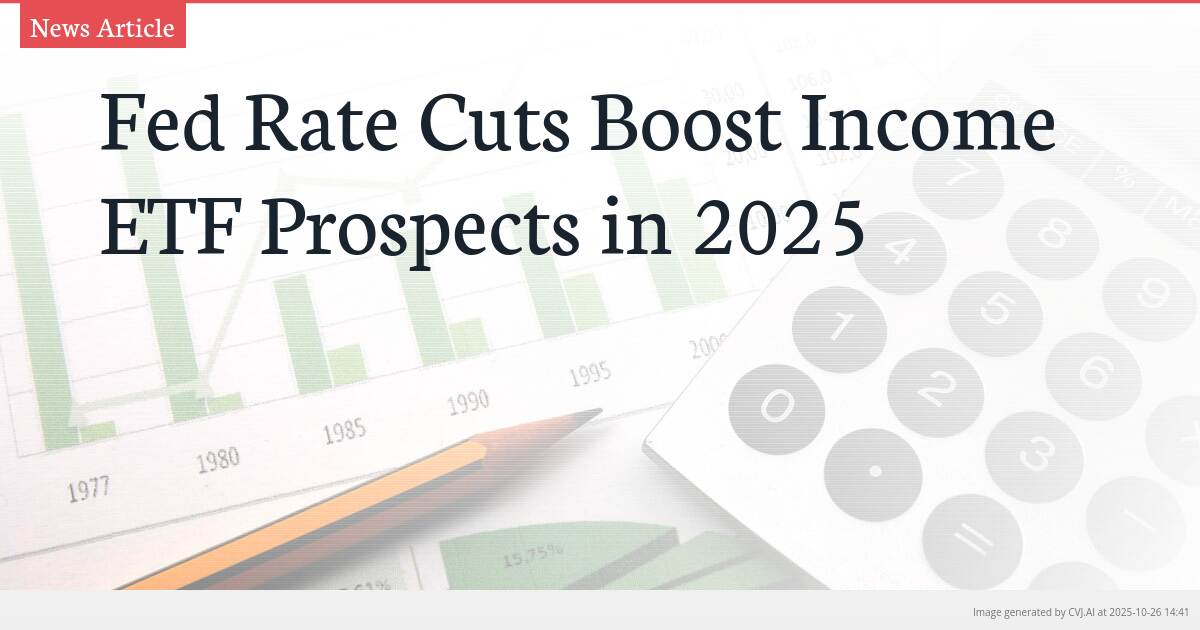This summary text is fully AI-generated and may therefore contain errors or be incomplete.
Introduction
The Federal Reserve’s projected interest rate cuts in 2025 are creating favorable conditions for income-oriented ETFs. BlackRock’s equity ETF head Jay Jacobs discusses how the firm’s products are positioned to benefit from this monetary policy shift, highlighting strategic options like the iShares US Large Cap Premium Income Active ETF (BALI) and iShares AI Innovation and Tech Active ETF (BAI) as investors seek income generation in evolving market conditions.
Key Points
- Federal Reserve plans two additional interest rate cuts in 2025, creating favorable conditions for income ETFs
- BlackRock's BALI ETF focuses on large-cap premium income generation through active management strategies
- BAI ETF targets AI innovation and technology sectors, offering exposure to growth areas alongside income potential
Federal Reserve Policy Shift Creates ETF Opportunities
The Federal Reserve’s indication that it plans to implement two additional interest rate cuts in 2025 marks a significant turning point for income-focused investment strategies. This monetary policy direction represents a departure from the higher-rate environment that has characterized recent years, creating new opportunities for exchange-traded funds designed to generate consistent returns. The shift comes as the central bank balances inflation concerns with economic growth objectives, potentially creating a more favorable landscape for income-generating assets.
According to analysis from BlackRock, the world’s largest asset manager, this anticipated policy pivot could particularly benefit income-oriented ETFs that have been strategically positioned for such a transition. The changing interest rate environment affects everything from bond yields to equity valuations, making active management and strategic sector allocation increasingly important for investors seeking reliable income streams. As rates decline, the relative attractiveness of dividend-paying stocks and other income-generating securities typically improves, creating tailwinds for funds specifically designed to capitalize on these dynamics.
BlackRock's Strategic ETF Positioning
BlackRock’s US Head of Equity ETFs Jay Jacobs recently appeared on Market Catalysts with Julie Hyman to discuss how the firm’s ETF products are positioned to benefit from the evolving monetary policy landscape. The conversation highlighted BlackRock’s strategic approach to navigating interest rate changes, emphasizing products that combine income generation with growth potential. Jacobs’ insights underscore how sophisticated ETF strategies can help investors adapt to changing Federal Reserve policies while maintaining exposure to key market opportunities.
During the Market Catalysts discussion, Jacobs specifically highlighted two of BlackRock’s actively managed ETFs: the iShares US Large Cap Premium Income Active ETF (BALI) and the iShares AI Innovation and Tech Active ETF (BAI). These products represent complementary approaches to income generation in a declining rate environment. BALI focuses on large-cap companies with strong income-generating capabilities, while BAI targets the intersection of artificial intelligence innovation and technology sectors, offering growth potential alongside income characteristics.
The selection of these particular ETFs for discussion reflects BlackRock’s comprehensive approach to income investing in a changing rate environment. By combining traditional income strategies with exposure to technological innovation, the firm aims to provide investors with diversified approaches to capitalizing on Federal Reserve policy shifts. This dual focus acknowledges that successful income investing in 2025 will require both defensive positioning and growth exposure.
Income and Innovation: BALI and BAI ETFs Explained
The iShares US Large Cap Premium Income Active ETF (BALI) represents a core income strategy designed to capitalize on the Federal Reserve’s projected rate cuts. This actively managed fund focuses on large-cap US companies with strong income-generating potential, employing sophisticated options strategies and security selection to enhance yield. In a declining rate environment, BALI’s approach to premium income generation becomes particularly valuable as traditional fixed-income alternatives may offer lower returns.
Meanwhile, the iShares AI Innovation and Tech Active ETF (BAI) offers a different approach to income generation by targeting companies at the forefront of artificial intelligence and technological innovation. This fund recognizes that some of the most compelling income opportunities may emerge from growth sectors that also offer dividend potential or can be enhanced through active management strategies. BAI’s focus on AI innovation positions investors to benefit from both technological advancement and income generation in a lower-rate environment.
Together, these ETFs illustrate how sophisticated income strategies are evolving beyond traditional dividend-focused approaches. The combination of BALI’s large-cap income orientation with BAI’s innovation focus provides investors with complementary exposures that can help navigate the complexities of a shifting interest rate landscape. As Jay Jacobs emphasized during the Market Catalysts discussion, this diversified approach to income investing may become increasingly important as Federal Reserve policy continues to evolve through 2025.
📎 Read the original article on yahoo.com

